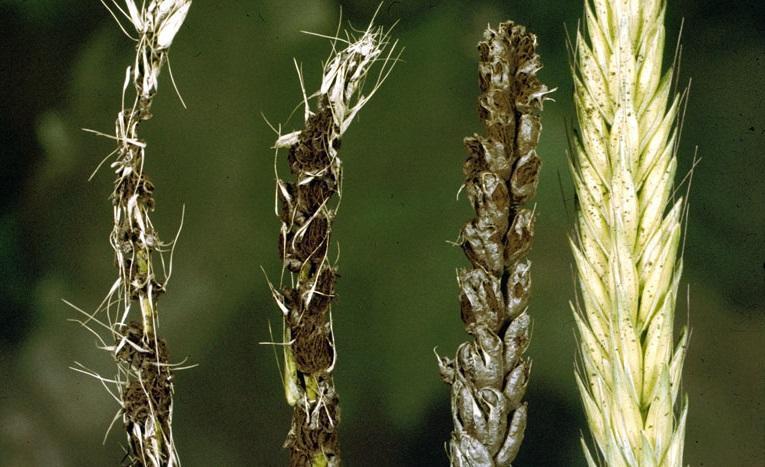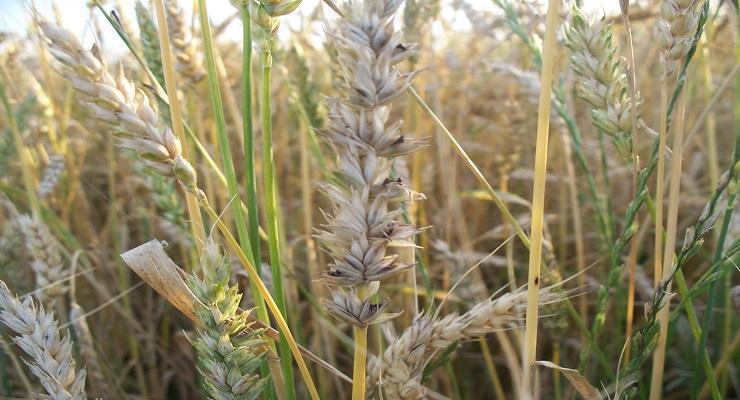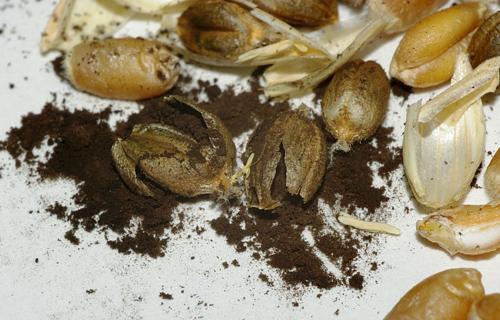Wheat common bunt (Tilletia spp.) – identify and control

Wheat common bunt (Tilletia spp.) is a disease known since antiquity, being reported in all countries where wheat is grown. The damages they cause are variable depending on the cultivated wheat variety, the pedoclimatic conditions, and the agrotechnical used.



Symptoms. The attacked plants are quite difficult to recognize until inspection. The only obvious symptoms are a 10-20% drop in height and a slight greenish-blue coloration of the leaves. At the boot stage, it is found that the affected ears have more grains in the spikelets. All spikelets have seeds (even those at the top and base of the spike), and the position of the spike remains straight until harvested.
The seeds have a slightly pronounced ventral groove and a dark (gray) color because inside them is a dusty mass of black spores. At threshing, the totally destroyed seeds are easily crushed. Sometimes there are only bags of spores inside the grain, because of this it crumbles. If wheat is not treated with systemic fungicides, the spores inside will produce infections in the fall.
The pathogen. The evolutionary cycle of the fungus takes place over an agricultural year. The infection takes place in autumn during germination, and the manifestation of the disease is observed only when the wheat is inspected. At threshing, the attacked seeds break and release the spores, which are deposited on the healthy seeds. When sown, untreated seeds bring spores into the soil. When wheat germinates at 14-16 ° C and there is sufficient moisture, it also germinates spores. The infectious mycelium enters the plant at the base of the plant or through wounds.
The attack takes place at 9-12 ° C in conditions of 60% soil moisture and lasts until the plants are 2 cm high. The mycelium grows at the same rate as the plant, reaching the ear, where a mass of black spores will appear. If the optimum time has been exceeded and the wheat has been sown too deep, the wheat common bunt attack is much stronger. Autumn wheat varieties are more sensitive than spring wheat.
Prevention and control. It is recommended to cultivate resistant hybrids, crop rotation, deep summer plowing on fields that have had wheat. The safest and most effective control is to treat wheat before sowing with specific fungicides
Recommended products
-
You can find products on a different store
Change Store -
You can find products on a different store
Change Store -
You can find products on a different store
Change Store -
You can find products on a different store
Change Store -
You can find products on a different store
Change Store -
You can find products on a different store
Change Store -
You can find products on a different store
Change Store -
You can find products on a different store
Change Store -
You can find products on a different store
Change Store -
You can find products on a different store
Change Store -
You can find products on a different store
Change Store -
You can find products on a different store
Change Store -
You can find products on a different store
Change Store -
You can find products on a different store
Change Store -
You can find products on a different store
Change Store -
You can find products on a different store
Change Store -
You can find products on a different store
Change Store -
You can find products on a different store
Change Store -
You can find products on a different store
Change Store -
You can find products on a different store
Change Store -
You can find products on a different store
Change Store -
You can find products on a different store
Change Store -
You can find products on a different store
Change Store -
You can find products on a different store
Change Store















































































































































































































































































































































































































































